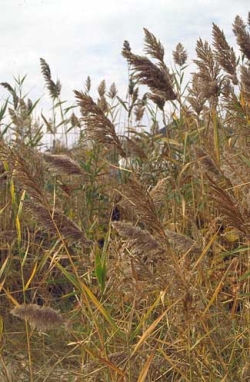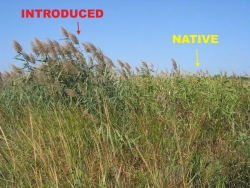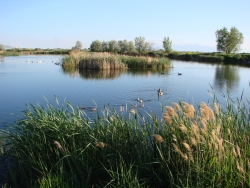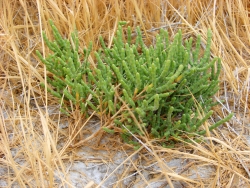
Copyright 2011
Wayne Wurtsbaugh, Photographer
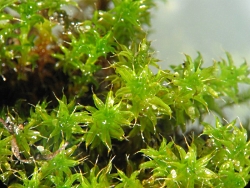 Tortula ruralis
Tortula ruralis
one of the few mosses
that are common in the desert
Courtesy Wikimedia
Licensed under CCA 3.0
Kristian Peters, Photographer
Hi, I’m Holly Strand from Utah State University’s Quinney College of Natural Resources.
Algae and moss are plentiful in and around Utah streams and lakes. But lots of people confuse these two kinds of plants. So let’s sort out what each one is.
First, both moss and algae are ancient plant forms that are commonly found in wet or moist places. As primary producers both algae and moss use sunlight to fix energy, giving off oxygen as a byproduct.
Neither algae nor moss has a vascular system to transport water so vertical growth is not their strong suit. Rarely more than an inch tall, a cushion of moss is really a tight cluster of individual moss plants. Bunching helps support the individual moss structures and helps conserve water. Meanwhile, algae comes in many forms, from microscopic one-celled diatoms to huge colonies of giant floating mats, or long flowing filaments. Algae also comes in many colors, such as green, gold, brown and red.
So where are they found? Moss loves shade. Look for it in the deep shadowy gorges and box canyons of the Colorado and Green Rivers. It also thrives in drainages off cliffs and around springs. Damp meadows, tree bases, bogs, and pond edges make great moss habitat. You will seldom find moss in saline environments. Some moss species live submerged in water but most live on land. With the sun-loving algae, the opposite is true—most live in water but some species will grow on damp soil and on the shaded sides of damp walls and trees.
Moss grows very slowly and lives a long time. So it needs a stable environment in which to grow. In contrast, algae is extremely fast-growing. A generation might last from one to several days. Algae is also extremely sensitivity to chemical, temperature and light conditions. Therefore, the presence, absence or quantity of algal species can be a useful indicator of ecosystem health. For instance, your aquatic system is probably in pretty good shape if a number of different species are flourishing. However, if the water is dominated by one or just a few fast growing species and the water starts to turn color—usually green—the system is seriously out of whack. Called algal blooms, these dramatic explosions of growth are usually the result of excess phosphorus or nitrogen runoff in the water.
During blooms the algal mass produces lots of oxygen during the day, but it consumes more than it makes at night. Further, more dead organic material is produced which eats up more oxygen. The result is a severe oxygen deficit. Resident fish, insects, and plants are deprived of oxygen and end up suffocating.
Go to www.wildaboututah.org for links to information on how to prevent algal blooms.
Thanks to 4th grade classes of Fallon Farokhi and Andrea Bostwick for their interest in moss, algae and water quality. Funded by an environmental education grant from the EPA Region 8, the 4th graders investigated and reported on water quality issues in the Bear River watershed. Also, thanks to Wayne Wurtsbaugh and Chuck Hawkins of Utah State University’s College of Natural Resources for their expertise in writing this piece.
For Wild About Utah, I’m Holly Strand.
Credits:
Image: Algae, Courtesy & Copyright Wayne Wurtsbaugh, Utah State University, Department of Watershed Sciences
Image: Moss, Licensed through the Attribution-ShareAlike 3.0 Unported (CC BY-SA 3.0) Courtesy Wikimedia, Kristian Peters, Photographer
Text: Holly Strand, Utah State University, Quinney College of Natural Resources
Sources & Additional Reading
US EPA. Harmful Algal Blooms https://www2.epa.gov/nutrientpollution/harmful-algal-blooms
US EPA. The Effects of Nutrient Pollution and Harmful Algal Blooms] https://www2.epa.gov/nutrientpollution/effects
US EPA. What You Can Do to Reduce Nutrient Pollution https://www2.epa.gov/nutrientpollution/what-you-can-do
Barbour, M.T., J. Gerritsen, B.D. Snyder, and J.B. Stribling. 1999. Rapid Bioassessment Protocols for Use in Streams and Wadeable Rivers: Periphyton, Benthic Macroinvertebrates and Fish, Second Edition. EPA 841-B-99-002. U.S. Environmental Protection Agency; Office of Water; Washington, D.C. https://water.epa.gov/scitech/monitoring/rsl/bioassessment/
Fisher, S.G. 1995. Stream Ecosystems of the Western United States. In River and Stream Ecosystems of the World, edited by Colbert E. Cushing, Kenneth W. Cummins, G. Wayne Minshall. NY: Elsevier
Flowers, Seville. 1973. Mosses: Utah and the West. Edited by Arthur Holmgren.
Moss, Brian. 2010. Ecology of Freshwaters. A View for the Twenty-First Centruy. Wiley-Blackwell.
Utah Division of Water Quality. Nutrients in Utah’s Waters https://www.nutrients.utah.gov/
Utah Water Research Laboratory. 2002. Understanding Nitrate Pollution in Small and Native American Communities. Water Treatment Technology Program Report No. 53. Washington DC, U.S. Department of the Interior.

